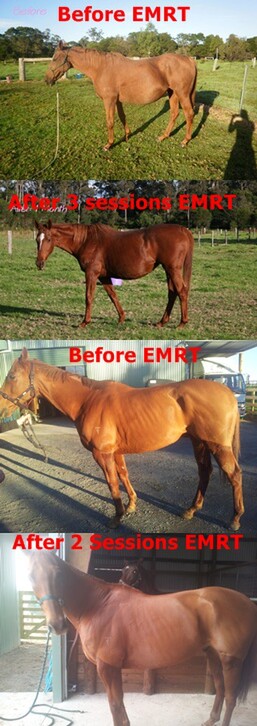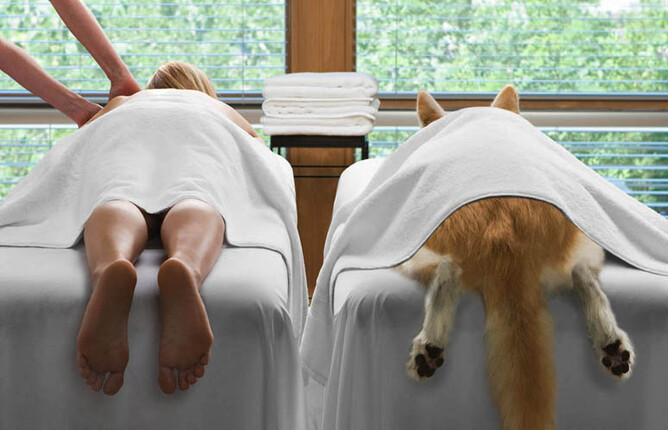Is Muscle Release Therapy a team effort ? before becoming a animal therapist whenever I heard Holistic therapy I would run a mile thinking that holistic was your usual airy fairy type therapy and not for me. As I started studying and understanding the actual meaning of holistic health I realised that being a animal muscle release therapist is actually a team effort to help an animal achieve optimal health in conjunction with your vet, farrier, dentist, trainer and etc.
VETERINARIAN
Muscle release can benefit a vet's clients by helping a horse recover from the effects of travel, stabling, surgery or weight-bearing lameness, especially when the animal has or has had to wear a cast, to help restore muscles from disuse atrophy or overuse of the unhampered legs. Muscle release can reduce or remove scar tissue. It's valuable during and after stall rest, after a difficult birth, to help rehabilitate rescue cases, and after musculoskeletal injuries due to falling, pulling back or flipping over, being caught in quicksand or fences, trailer accidents and so on.
For muscle release therapists, veterinary consultation is essential. Many diseases and conditions can affect soft tissues; it's important to rule them out and to work in harmony with any ongoing medical treatments or concerns.
FARRIER
It's easier for a farrier to provide a balanced hoof when there is a balance in the muscles/tendons of the legs and the body, and the forces acting on the hoof are evenly distributed. Muscle release therapy promotes soundness by maintaining or restoring elasticity in leg and pastern ligaments; it helps maintain a healthy range of motion in the leg joints.
With muscle release, the upper body maintains its ability to distribute the forces of locomotion, thus reducing concussion on the hooves. Back, shoulder and hip joints remain pain free so when the farrier picks up a leg, the horse is easily able to shift its weight.
For the muscle release therapist a good farrier is essential. Because the legs are long levers, their condition has a profound effect on the body; chronic hoof pain, imbalance or joint strain strongly affects the horse's overall tension, straightness and balance.
EQUINE DENTIST
Pre-dental muscle release relieves muscle contracture in the poll, upper neck, hyoid apparatus and TMJ, which might tend to distort dental balance and jaw function. After dental work, muscle release helps relieve general pain and tension resulting from pre-treatment problems as well as the treatment posture. It helps the horse more quickly regain normal jaw function and freedom of neck, head and shoulders.
For the muscle release therapist, trying to work with a horse that has significant dental imbalance or pain can be frustrating. Often poll, neck, shoulder and lumbar back tension and weakness can be relieved simply by eliminating dental problems.
TRAINER
Muscle Release therapy can help a horse be focused, and provide a relaxed response system rather than bracing and resisting. A calm, trusting horse is easier to train, has better balance, and can maintain peak performance. Muscle Release Therapy can enhance body awareness - for the rider and for the horse - and can help answer that eternal question, "Is it just a bad attitude?"
A thoughtful trainer improves the horse's ability to go freely forward under saddle; letting go of any mental bracing or resistance in the body provides immediate physical benefits. Thoughtful training also supports bodywork by following up with therapeutic exercises and warm-up routines that build the horse's health, and by helping the client learn to ride so as to maintain healthy posture and movement
Lastly, a horse, young or old, a muscle therapist would want to be aware of, and explain to the client, that after a muscle release session, a horse that has been compensating in numerous areas throughout the body may come up lame or short after the session. It will take two to three days to see the improvement after a session and that is why it is always expressed to give horses a few days off to get the most of session and the results.
I personally tend to have neck and shoulder restrictions which usually turn into painful migraines and anti-inflammatories can only relieve the pain slightly. After a Myo-fascial /Acupuncture / Osteopathic session it usually takes approx. a day for the pain to end and to be back to normal and with no more pain for a couple of months or until I re-injure myself again.
Thus, in my opinion muscle release therapy does help with a more holistic approach towards animal health. The meaning of holistic does not make me run anymore now that I have a better understanding of it.
I think more vets & farriers are starting to open up in understanding and assessing therapies such as muscle release and acupuncture to complement conventional medicine which can help the overall wellbeing of an animal which in turn will help use of conventional medicine with better results.
AMRT is best applied as a complementary technique, promoting the well-being of the animal and assisting conventional therapies to achieve a positive result.
While based on concepts that seem at first difficult to understand and are labeled ‘alternative’, the Therapies I utilise such as Myo-fascial Release, Acupuncture, Laser, Osteopathic techniques are more correctly considered part of an integrative approach to case management that gathers all relevant treatment options and applies them with consideration of the animal as a whole (holistic)


